I had never given much thought to the origins of folktales until 2017, when I started my On the Ceiling project. My inspiration for the project, naturally, came from the legends of Kwaku Ananse, famous in much of West Africa, the Caribbean, and beyond. More recently, in 2024, I had the opportunity to dive much deeper into the research of Kwaku Ananse, his origins (not as straightforward as you might think), the processes by which is name and his tales travelled across the Atlantic (a more complex process than you might realize) and what the character and his stories might mean to the populations around the world who speak of them. And, of course, I got to touch on the processes by which folktales—specifically Ananse’s—are formed. The fruit of my labor is an extended essay about 30,000 words long (including some classic tales retold in my own words) and it is now available to read in the Flame Tree Press publication, ANANSI.

My essay takes up most of the first half of the book. The second half is full of reimagined Ananse stories by a selection of writers, and I definitely think it’s worth owning a copy of. Ghanaian booksellers, please order some copies for retail! I can almost guarantee that once your clients know this book exists, it will disappear rather quickly from your shelves. Readers, add it to your TBR!
Now, back to On the Ceiling.
As I worked on the first part of the project—which involved turning the classic Asante version of Kwaku Ananse into a 21st-century teenage girl called Kuukua Annan—the seed of the second part of the project had already started to form in my mind. Because it occurred to me that I was probably reverse-engineering elements of the Ananse stories I’d heard throughout my life. Genres are interesting and fascinating things. The elements that are entirely normal in one genre become utterly absurd in another. In transposing Kwaku Ananse’s Asante canon into what may be described as modern YA literature, I had to find ways to make the nonsensical elements that belong perfectly in folklore, now make sense outside of it.
To write Kuukua’s stories, I had taken these folklore characters—mostly anthropomorphic animals—and turned them into human beings in the “real world” of my fictional universe. I engineered explanations for how Kwaku Ananse could possibly have so many stories about him, how he could play so many tricks in “one” lifetime, how he could meet his death in several tales only to be alive in the next ones. [Spoiler alert (it’s revealed in the first story, don’t worry): I decided it’s because Kwaku Ananse has been many different people throughout time, and Kuukua Annan was only the latest in a long legacy to inherit the title.]
I reverse-engineered human characters’ names based on folklore characters’ names: Okonore Yaa (Kwaku Ananse’s wife) became Yaw Connor. Tikelenkele (one of Kwaku Ananse’s sons) became a boy called Keshawn whose head was so large that his classmates nicknamed him “Ti Kɛseɛ.” Nankonwheaa (another of Kwaku Ananse’s sons) became a teenage girl with extremely long legs, remarkable athletic prowess, and dreams of a future at the Olympics. Ntikuma (Kwaku Ananse’s firstborn son) became Ntiwaa.
For every trick Kuukua played, each seemingly impossible feat there was a rational explanation for the mysterious effects. In most cases, they were strokes of engineering genius, created with invisible spools of spider-silk thread.
But the more I thought about how I was unmaking folktale elements, unraveling their threads and retying them into new configurations, the more I thought about the opposite process—how real-life events might eventually turn into the stuff of legend. What if every Ananse story was based on something a human “Ananse” did? What if I created original “folktales” based on every single thing my own Kuukua Annan did?
That’s how the idea of OTC 2: Green Green Grasses, the scripted podcast, was born.

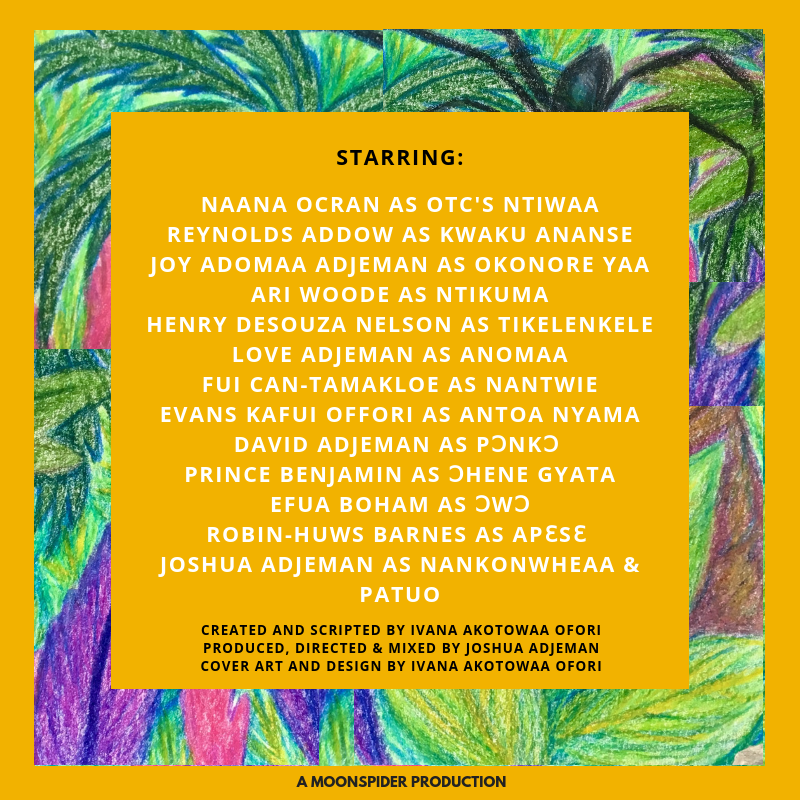
I couldn’t help but reflect on how, in many of the Ananse stories I remembered, Ananse was humiliated in the end, while Ntikuma came out on top. I couldn’t help but recall that quote, versions of which are attributed to Chinua Achebe as often as to the wide bank of African proverbs: “Until the lions have their own historians, the history of the hunt will always glorify the hunter.” I concluded, therefore, that the reasons the stories were so flattering to Ntikuma was because Ntikuma was the one telling the stories! (Those of you who have listened to Green Green Grasses might have realized that my voice begins each episode with the following line: “Until Kwaku Ananse himself is the one to tell his own story, the tales will always glorify Ntikuma.”) In the world of OTC, my counterpart to Ntikuma was Ntiwaa, Kuukua’s least favorite cousin.

To make Green Green Grasses fit within the universe I had created, I had several requirements. Namely:
- A storyteller who personally witnessed all of Kuukua’s feats in OTC 1: The Complete Kuukua Collection in order to twist them into folktales later;
- The storyteller having a wild imagination;
- The storyteller having the type of audience that justified the transposition of real-life experiences into folktale form;
- The storyteller having a bit of a vendetta against “Kwaku Ananse.”
- Let’s take them one by one.
Ananse’s Witness Twists the Tale
In the very first OTC story, “Kuukua and the Magical Markers,” Kuukua’s cousin, Ntiwaa, is firmly established as a storyteller—the best in her class. Throughout the 8 stories in the Kuukua Collection, Ntiwaa is present for at least some portion of the trick Kuukua plays. This device helped me to justify why Ntiwaa is able to narrate all eight episodes of Green Green Grasses. Because every single story is a radically reworked retelling of one of the tricks she literally witnessed Kuukua play.
Notice that OTC1 #1 (Kuukua and the Magical Markers) involves Ntiwaa scoring higher on a test than Kuukua, and OTC2 #1 (Why the Spider Uses Its Web to Catch Food) involves Ntikuma excelling at a test set by Anomaa, which Ananse just cannot manage to do.
OTC 1 #2 (“Kuukua and the Twisting Tablecloth”) features a bully of an uncle visiting Kuukua Annan’s home from abroad, while OTC 2 #2 (“How the Bull Got Curved Horns”) features a literal bull passing through Kwaku Ananse’s home on a long journey.
OTC 1 #3 (“Kuukua and the Haunted Hair”) involves Kuukua Annan getting revenge on some hairdressers, while OTC 2 #3 (“Why the Horse’s Mane Is Thin”) involves Kwaku Ananse outwitting a horse for the sake of his hair.
OTC 1 #4 (“Kuukua and the Sliding Sneakers”) features some swaggering cooler-than-thou secondary school faction leaders taken down a peg by Kuukua Annan, while OTC 2 #4 (“How the Lion Lost His Clothes”) features the “proudest” of all the animal kingdom’s creatures, the Lion, being taken down a peg by Kwaku Ananse.
And so on and so forth. I’m telling you one thing Akotowaa will do in this life as a storyteller is have fun.
[insert OTC Map blur 3]
A Wild Imagination
To have the capacity for this level of creative distortion, I had to furnish my storyteller with a wild and overactive imagination, hence Ntiwaa’s superstitious nature, as well as her history with Kumawood movies. Ntiwaa grew up in Kumasi and was so obsessed with the city’s juju film industry that she was quickly nicknamed “Nti-Kumawood” when she moved to Accra. 😉
An Appropriate Audience
Children! The eighth story in The Complete Kuukua Colelction ends just before Christmas 2017—the same month the story was released. And here’s the framing context I deliver at the beginning of each Green Green Grasses episode:
“In 2018, the teenage aspiring writer, Ntiwaa, composed eight original Anansesɛm stories, all inspired by incidents involving her cousin, Kuukua Annan. She volunteered at a kindergarten and told them to the children. They have now been recorded and released here – with Ntiwaa’s permission, of course. So, sit back and kick it with some original oral storytelling from a talented young woman. This, Ɔmanfoɔ, is Green Green Grasses.”
A Vendetta Against Ananse
And then, of course, Ntiwaa had to have an agenda—personal reasons for wanting to make the character who corresponded to her in the folktales (Ntikuma) come out on top and the character corresponding to Ananse come out disgraced. And so I gave her a reason: Kuukua is absorbing all the attention of a boy that Ntiwaa has a massive crush on: Yaw Connor. In Ntiwaa’s reality, Kuukua seems to get everything Ntiwaa wants, especially the quite boy. In Ntiwaa’s reality also, Kuukua seems to get away with every immoral plot and scheme, and no matter how hard Ntiwaa tries, just like Candace in the Disney TV show Phineas and Ferb, she can never “bust” Kuukua. But in the stories she writes, she has creative agency to flip the script—catharsis for her wounded pride, and she will take whatever victories she can get.
Process
I kid you not, friends, I wrote all eight episodes of Green Green Grasses in a single day. For this reason and others, the writing itself may be mediocre, and the achievement of my goals somewhat debatable, but I am still immensely proud the product even exists.
It was December 2017. I had just finished and released the eighth and final story in OTC 1: “Kuukua and the Killjoy Kente.” I was a college student in the USA, back home in Ghana for a matter of weeks during the Christmas break, and I was determined to make my wild idea come to life before I no longer had access to the magnificent (for an amateur, at least) resources at my disposal in Accra.
Luckily for me, I also had some incredibly talented people around me. I know some of you have heard Goodbye, Gold Coast, but let it be known that the first audio drama role played by the sensational Adomaa Adjeman was that of Okonore Yaa in Akotowaa’s OTC: Green Green Grasses. I think Reynolds (Ananse) and Ariel (Ntikuma) were such naturals that they should both really consider becoming actors. The loves of my life, including Naana Ocran and Fui-Can-Tamakloe, really came though for me with almost nonexistent notice.
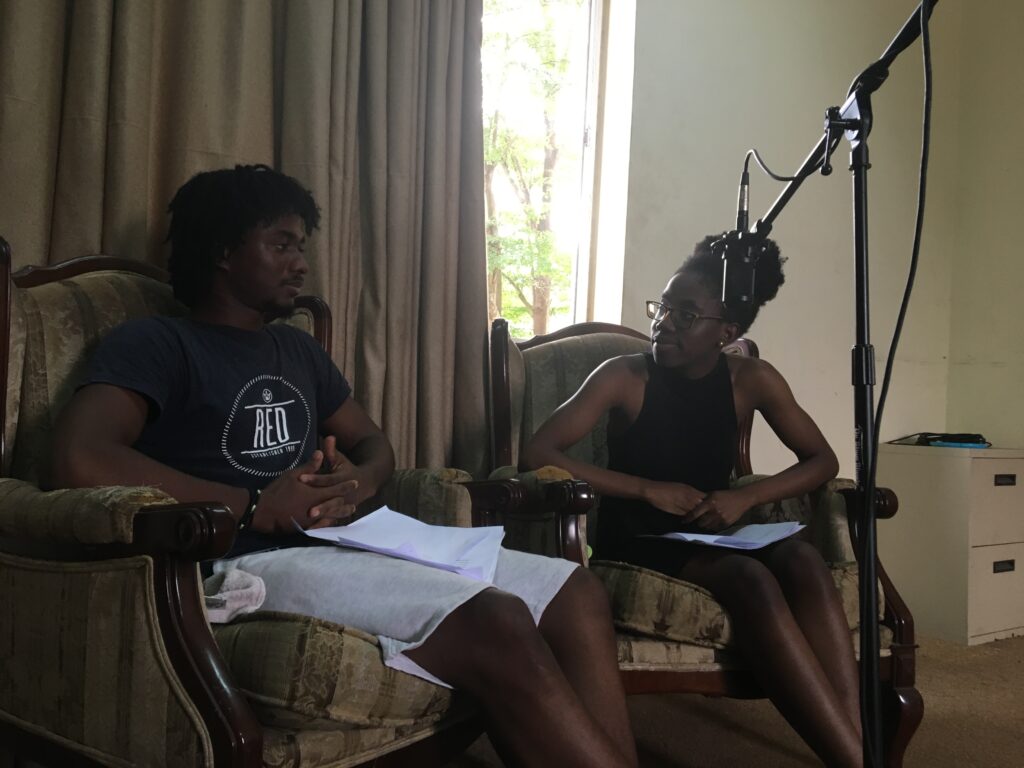
In fact, God bless everyone who showed up for me for this project. I dropped my ideas and my scripts on these people and between 24-48 hours, these people were in the studio with me, lips behind a pop filter, headphones over their ears. I really wish I had taken more photos and videos, but I rarely think about these things when I’m immersed in the moment.
Within two days, most of the episodes were fully recorded. The man who was my best friend at the time, and training to be a sound engineer—Joshua Adjeman—personally directed nearly every actor who came through over those two days to the makeshift studio in his house. When Joshua and I had both left Ghana again for our respective schools, Reynolds took over and directed the actors for the two remaining roles.
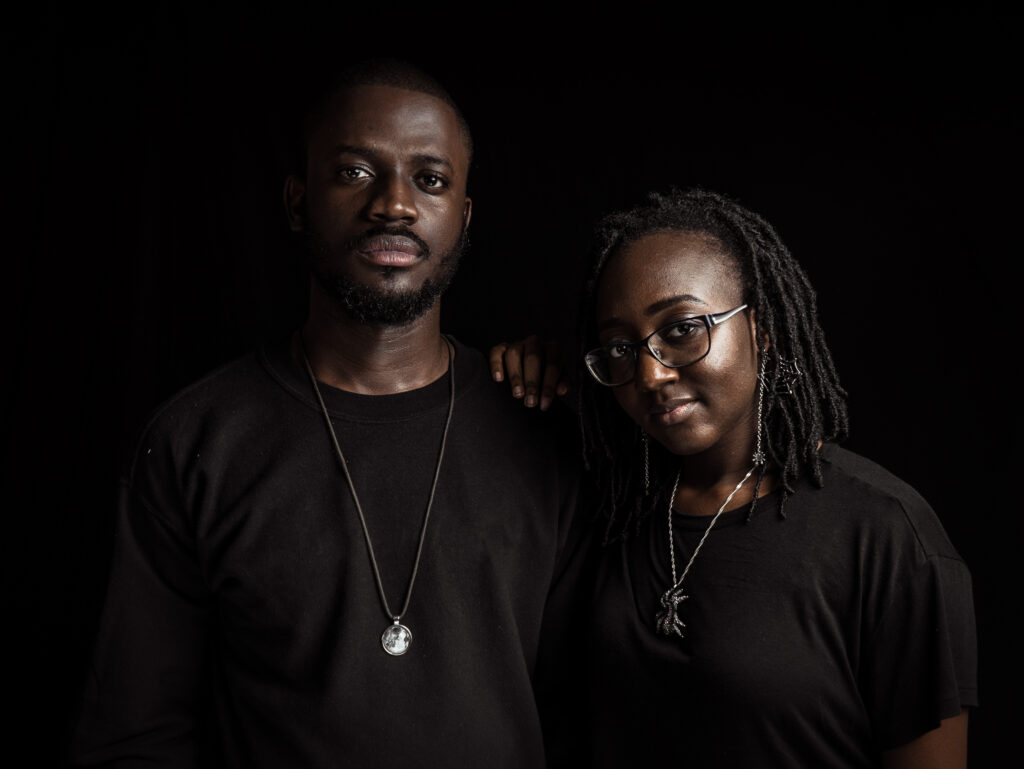
It took quite a bit of pushing to get Joshua to complete the editing and mixing of the episodes, hence the delay between recording and release, but we got there in the end!
I drew the image used for the podcast episode posters myself and put together the variations on Canva. I created my own trailer using Microsoft PowerPoint and a screen recording app: https://www.instagram.com/p/BpPu8dlFJOf
Now, OTC 2: Green Green Grasses exists. And OTC 3: The Okonore Trilogy, is coming.
A whole lot of work has gone into OTC over the years and continues to be poured into it. If you love the work, consider supporting my creative practice. And tell a friend to tell a friend to read, and to listen, and to anticipate the final arm of this project that is so dear to my heart!
🕸️, Akotowaa.
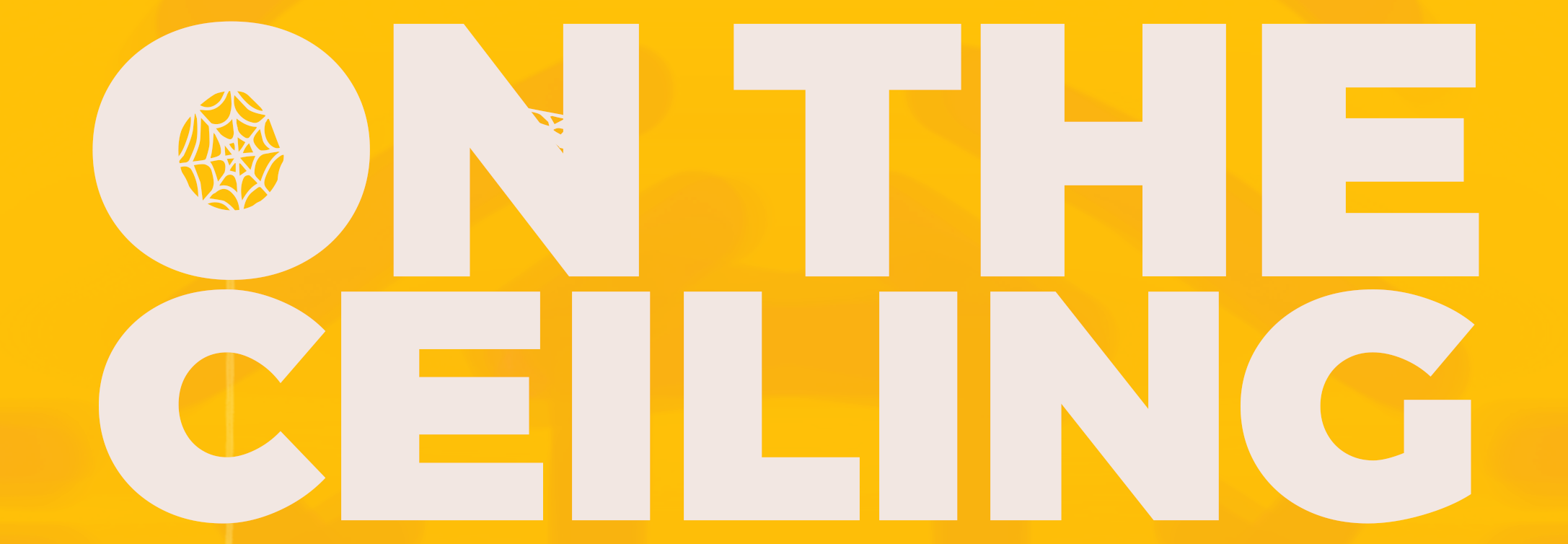

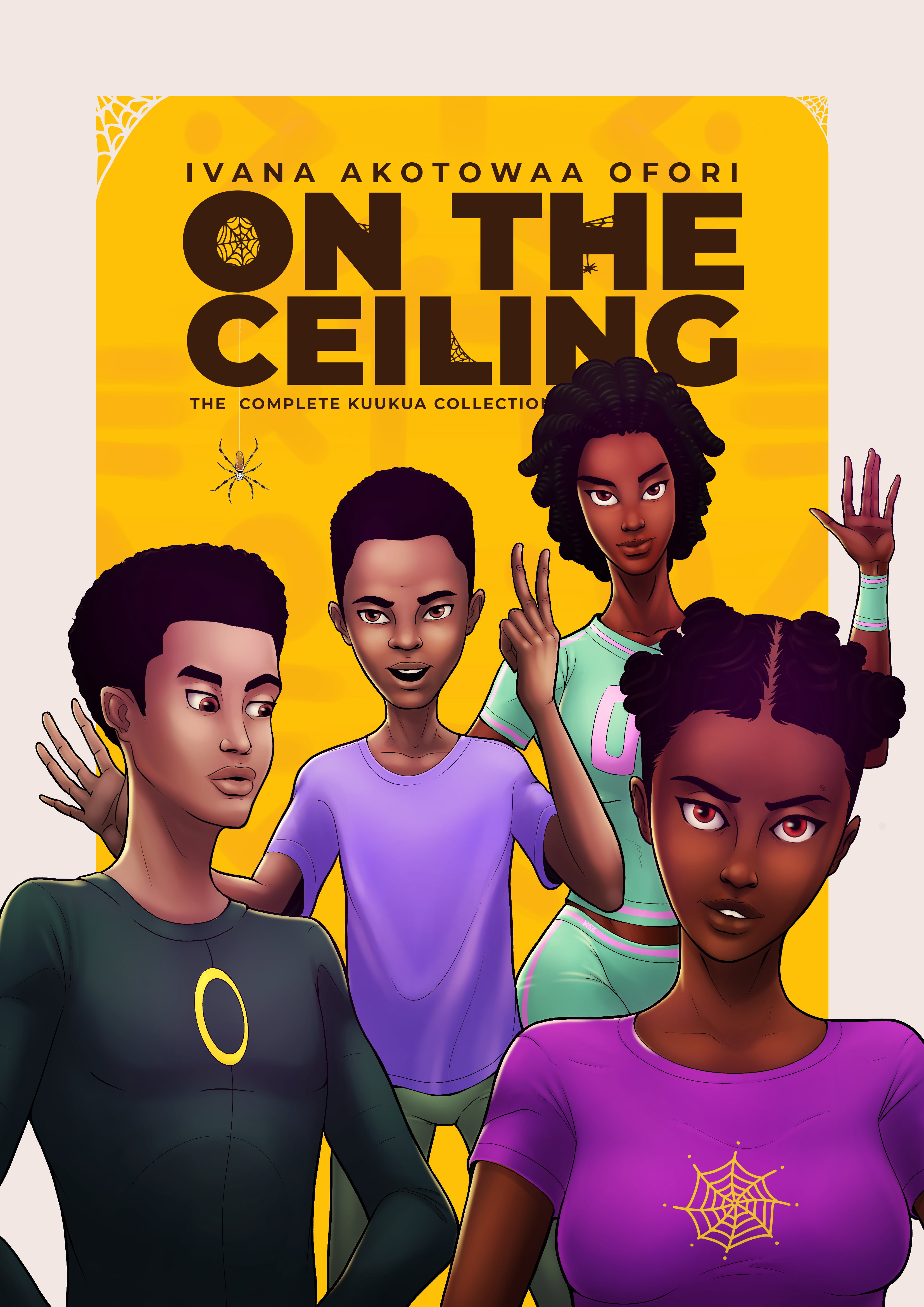
Leave a Reply